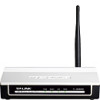TP-Link TL-WA500G User Guide - Page 37
DHCP, 4.5.1 DHCP Settings, TL-WA500G, Sent Packets, Refresh, Previous, DHCP Settings
 |
UPC - 845973051105
View all TP-Link TL-WA500G manuals
Add to My Manuals
Save this manual to your list of manuals |
Page 37 highlights
TL-WA500G 54M Wireless Access Point User Guide ¾ Sent Packets - Packets sent by the station. You cannot change any of the values on this page. To update this page and to show the current connected wireless stations, click Refresh. If the numbers of connected wireless stations go beyond one page, click Next to go to the next page and click Previous to return the previous page. ) Note: This page will be refreshed automatically every 5 seconds. 4.5 DHCP DHCP stands for Dynamic Host Configuration Protocol. The DHCP Server will automatically assign dynamic IP addresses to the computers on the network. This protocol simplifies network management and allows new wireless devices to receive IP addresses automatically without the need to manually assign new IP addresses. There are three submenus under the DHCP menu (shown as Figure 4-20): DHCP Settings, DHCP Clients List and Address Reservation. Clicking any of them will enable you to configure the corresponding function. The detailed explanations for each submenu are provided below. Figure 4-20 The DHCP menu. 4.5.1 DHCP Settings Selecting DHCP > DHCP Settings will enable you to set up the AP as a DHCP (Dynamic Host Configuration Protocol) server, which provides the TCP/IP configuration for all the PCs that are connected to the system on the LAN. The DHCP Server can be configured on the page (shown as Figure 4-21): 30















